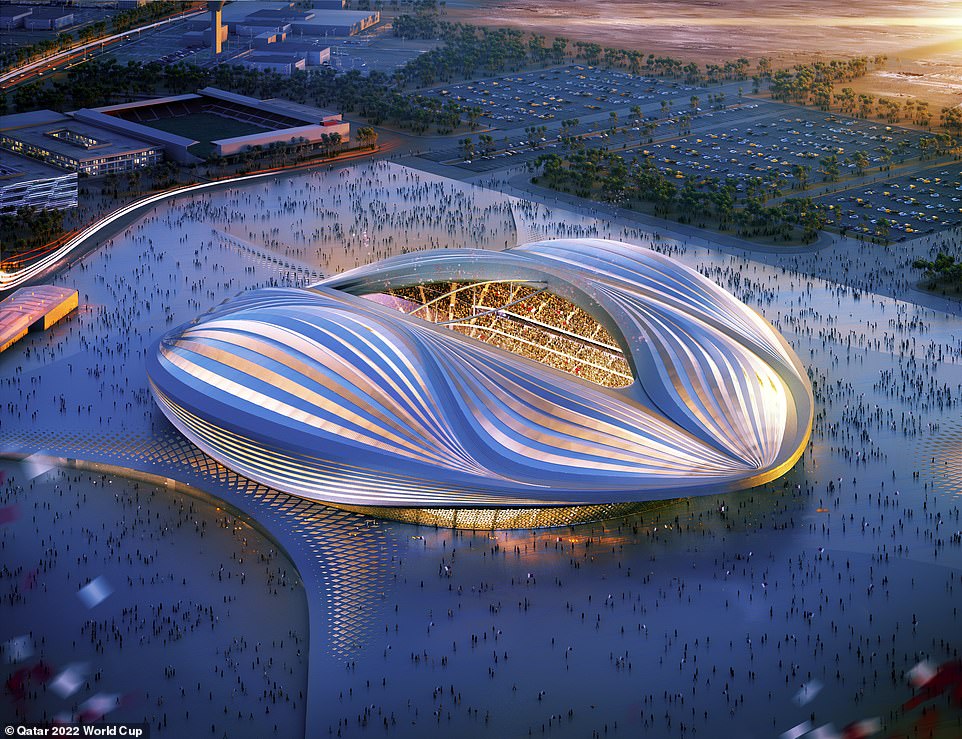One of the new stadiums under construction for the 2022 World Cup in Qatar, dubbed the ‘vagina stadium’, is taking shape ahead of its completion next year.
Construction of the 40,000-seater venue in the port of Al-Wakrah is due to be finished in 2019, three years ahead of the start of the tournament.
It will be one the last designs by British architect Dame Zaha, who died suddenly of a heart attack in 2016, aged 65.
Among her other works were the Aquatics Centre at the 2012 London Olympics, the MAXXI Museum in Italy and the Guangzhou Opera House in China.
When the Al-Wakrah stadium’s designs were first released in 2013 they were said to have been inspired by the flowing shape of a dhow boat, a traditional Arabian pearl diving and fishing vessel.
The drawings were topped with a structure resembling the sails of a dhow.
But the images went viral with commentators suggesting the stadium looked more like a woman’s private parts.
At the time Dame Zaha was angry at the comparison, saying: ‘It’s really embarrassing they come up with nonsense stuff like this. What are they saying? Everything with a hole in it is a vagina? That’s ridiculous.’
Iraqi-born Hadid, who won the prestigious Pritzker Architecture Prize in 2004, added that ‘if a guy had done this project there wouldn’t have been the same level of criticism’.
The Al-Wakrah stadium, which is 12 miles south of the capital, Doha, was designed to keep out the desert heat and will also use a revolutionary new air-conditioning technology which will bring temperatures down to around 72F for the fans and players.
The tournament has already been moved to the winter months to avoid the searing summer temperatures in the Gulf.
As part of its legacy for the 2022 World Cup Qatar will be dismantling the stadium afterwards for it to be rebuilt in the developing world.
More than 20,000 seats will be removed from Al-Wakrah and transported to countries in need of football infrastructure.
In its promotional material, Aecom, the firm that won the Al-Wakrah contract with Zaha Hadid Architects, said of the designs: ‘Inspired by the dhow boat that carried generations of local fishermen and pearl divers, the stadium weaves together Qatar’s past with it progressive vision for the future.
‘Sustainable materials and practices will be used throughout the stadium and the pitch and spectator stands will be cooled to a perfect temperature for football.’
But some critics thought the unintentional comparison with female genitalia was for the good.
One said: ‘In a world where sport and vaginas very rarely come together with such prominence (see every UK female footballer’s salary versus every UK male footballer’s salary), the likeness can only be a good thing.
‘After all why not have 45,000 people crammed inside a woman’s reproductive system? It’s not like they haven’t been there before.’
Qatar is building eight stadiums for a 32-team World Cup, although FIFA boss Gianni Infantino has said he would like to expand the tournament to 48 teams, which would involve Doha co-hosting with its Arab neighbours.
He has admitted the chance of this is small because of a Saudi-led blockade of Qatar, but ‘worth trying’.
With exactly four years from the start of the FIFA World Cup in Qatar the eight stadiums that will play host to the tournament are taking shape.
It will be the first time the tournament will not be staged during the summer – kicking off on November 21 and running for just 28 days through to December 18.
All eight venues are situated with a 21-mile radius of central Doha and will be linked by a metro and tram system, making it possible to watch more than one game in the same day.
The tournament organisers are confident all of the stadiums and other infrastructure will be finished in good time.
Credit: DailyMail.co.uk
